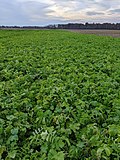Cover crop
Cover crops are plants grown primarily to improve and protect the soil during periods when main crops are not cultivated. They play a crucial role in sustainable agriculture by enhancing soil health, reducing erosion, improving water infiltration, and managing pests and weeds. Cover crops can include a variety of grasses, legumes, and other green plants used in rotation with regular crops.
Benefits of Cover Crops[edit]
Cover crops offer numerous benefits to the soil and the environment, including:
- Soil Erosion Control: By providing ground cover, they reduce the impact of rain and wind on the soil, thus preventing erosion.
- Soil Health Improvement: They add organic matter to the soil, improving its structure, nutrient content, and overall health.
- Weed Suppression: The dense growth of cover crops can outcompete weeds, reducing the need for herbicides.
- Pest Management: Certain cover crops can suppress soil-borne pests and diseases or provide habitat for beneficial insects.
- Water Management: They help in water infiltration and moisture retention in the soil, reducing the need for irrigation.
- Nitrogen Fixation: Leguminous cover crops can fix atmospheric nitrogen into the soil, reducing the need for synthetic fertilizers.
Types of Cover Crops[edit]
Cover crops can be broadly classified into two categories based on their lifecycle: annuals and perennials. Furthermore, they can be categorized based on their family, such as legumes, grasses, and brassicas.
- Legumes: Such as clover, vetch, and peas, are valued for their ability to fix atmospheric nitrogen.
- Grasses: Including cereal rye, oats, and barley, are excellent for improving soil structure and organic matter.
- Brassicas: Like radishes and mustards, are known for their deep roots that can break up compacted soil.
Selection and Management[edit]
The selection of a cover crop depends on the specific goals, such as nitrogen fixation, erosion control, or weed suppression. It also depends on the climate, soil type, and the main crops grown in the rotation. Proper management of cover crops is crucial for maximizing their benefits. This includes timely planting and termination, choosing the right species mix, and integrating them into the crop rotation plan.
Challenges[edit]
While cover crops offer numerous benefits, there are also challenges in their adoption, including additional costs, labor, and the need for specialized knowledge in managing them effectively. Moreover, the termination of cover crops, especially in no-till systems, requires careful planning to avoid competition with the main crops.
Conclusion[edit]
Cover crops are a key component of sustainable agriculture, offering significant benefits to soil health, water management, and biodiversity. Despite the challenges, their integration into farming systems can lead to long-term environmental and economic benefits.

This article is a agriculture stub. You can help WikiMD by expanding it!
-
A cover crop of Tillage Radish in early November
-
Northwestern South Dakota cover crops, 2015
-
Hairy vetch cover crop
Ad. Transform your life with W8MD's Budget GLP-1 injections from $75


W8MD offers a medical weight loss program to lose weight in Philadelphia. Our physician-supervised medical weight loss provides:
- Weight loss injections in NYC (generic and brand names):
- Zepbound / Mounjaro, Wegovy / Ozempic, Saxenda
- Most insurances accepted or discounted self-pay rates. We will obtain insurance prior authorizations if needed.
- Generic GLP1 weight loss injections from $75 for the starting dose.
- Also offer prescription weight loss medications including Phentermine, Qsymia, Diethylpropion, Contrave etc.
NYC weight loss doctor appointmentsNYC weight loss doctor appointments
Start your NYC weight loss journey today at our NYC medical weight loss and Philadelphia medical weight loss clinics.
- Call 718-946-5500 to lose weight in NYC or for medical weight loss in Philadelphia 215-676-2334.
- Tags:NYC medical weight loss, Philadelphia lose weight Zepbound NYC, Budget GLP1 weight loss injections, Wegovy Philadelphia, Wegovy NYC, Philadelphia medical weight loss, Brookly weight loss and Wegovy NYC
|
WikiMD's Wellness Encyclopedia |
| Let Food Be Thy Medicine Medicine Thy Food - Hippocrates |
Medical Disclaimer: WikiMD is not a substitute for professional medical advice. The information on WikiMD is provided as an information resource only, may be incorrect, outdated or misleading, and is not to be used or relied on for any diagnostic or treatment purposes. Please consult your health care provider before making any healthcare decisions or for guidance about a specific medical condition. WikiMD expressly disclaims responsibility, and shall have no liability, for any damages, loss, injury, or liability whatsoever suffered as a result of your reliance on the information contained in this site. By visiting this site you agree to the foregoing terms and conditions, which may from time to time be changed or supplemented by WikiMD. If you do not agree to the foregoing terms and conditions, you should not enter or use this site. See full disclaimer.
Credits:Most images are courtesy of Wikimedia commons, and templates, categories Wikipedia, licensed under CC BY SA or similar.
Translate this page: - East Asian
中文,
日本,
한국어,
South Asian
हिन्दी,
தமிழ்,
తెలుగు,
Urdu,
ಕನ್ನಡ,
Southeast Asian
Indonesian,
Vietnamese,
Thai,
မြန်မာဘာသာ,
বাংলা
European
español,
Deutsch,
français,
Greek,
português do Brasil,
polski,
română,
русский,
Nederlands,
norsk,
svenska,
suomi,
Italian
Middle Eastern & African
عربى,
Turkish,
Persian,
Hebrew,
Afrikaans,
isiZulu,
Kiswahili,
Other
Bulgarian,
Hungarian,
Czech,
Swedish,
മലയാളം,
मराठी,
ਪੰਜਾਬੀ,
ગુજરાતી,
Portuguese,
Ukrainian


